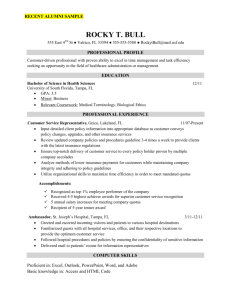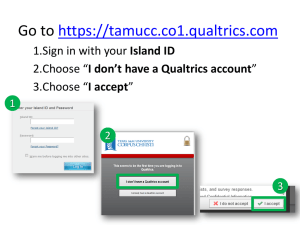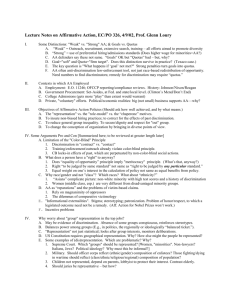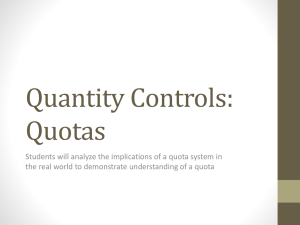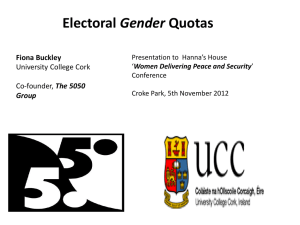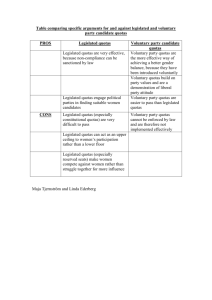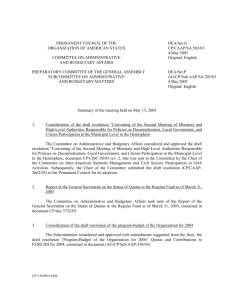Quotas in the Scottish Parliament
advertisement
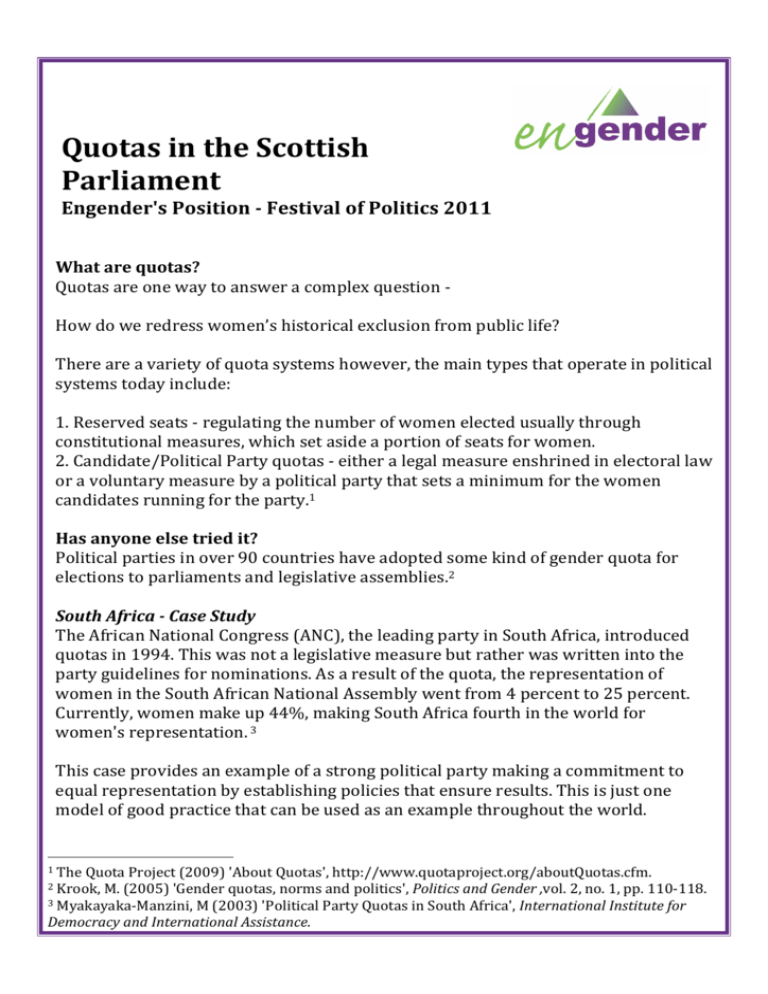
Quotas in the Scottish Parliament Engender's Position -­ Festival of Politics 2011 What are quotas? Quotas are one way to answer a complex question -­‐ How do we redress women’s historical exclusion from public life? There are a variety of quota systems however, the main types that operate in political systems today include: 1. Reserved seats -­‐ regulating the number of women elected usually through constitutional measures, which set aside a portion of seats for women. 2. Candidate/Political Party quotas -­‐ either a legal measure enshrined in electoral law or a voluntary measure by a political party that sets a minimum for the women candidates running for the party.1 Has anyone else tried it? Political parties in over 90 countries have adopted some kind of gender quota for elections to parliaments and legislative assemblies.2 South Africa -­ Case Study The African National Congress (ANC), the leading party in South Africa, introduced quotas in 1994. This was not a legislative measure but rather was written into the party guidelines for nominations. As a result of the quota, the representation of women in the South African National Assembly went from 4 percent to 25 percent. Currently, women make up 44%, making South Africa fourth in the world for women's representation. 3 This case provides an example of a strong political party making a commitment to equal representation by establishing policies that ensure results. This is just one model of good practice that can be used as an example throughout the world. 1 The Quota Project (2009) 'About Quotas', http://www.quotaproject.org/aboutQuotas.cfm. 2 Krook, M. (2005) 'Gender quotas, norms and politics', Politics and Gender ,vol. 2, no. 1, pp. 110-­‐118. 3 Myakayaka-­‐Manzini, M (2003) 'Political Party Quotas in South Africa', International Institute for Democracy and International Assistance. What are the pros? • Quotas are a fast track to equality, compensating for the persistent barriers that women face when seeking public office. o Quotas help to open the door to more women. They can be a temporary measure to create a lasting change in political culture. • Quotas help democratic institutions be more representative of the populations they serve. o Women have valuable perspectives that need to be heard in our representative bodies and therefore should be equally represented in our democratic bodies. • Women's experiences are needed to inform policy in public life. o Women are mothers, carers, and active members of the economy. Their experiences bring valuable insight and a balanced approach to policy making. • Quotas can facilitate more inter-­‐party democracy as they can help to formalise and make recruitment rules more transparent. o Making quotas a formal candidate selection mechanism encourages parties to evaluate their processes and encourages them to consider equality throughout all their practices. What are the cons? • If we need quotas for women then we need quotas for ethnic minorities, disabled people, and LGBT. o We may also need to use quota for minority groups, but women are not a minority. Women make up half the population and need to make up half of our political representation. • Quota women are token women. Quotas imply politicians were elected for their gender and not because they are the most qualified candidate. o Quotas are not intended to help women to positions of power because they are women, without requiring them to have experience. Women already have merit; this is not the issue. Quotas are a mechanism used to eliminate some of the shortcomings of democracy; the focus is on representation, not merit. 4 • Quotas are undemocratic, voters should be able to decide who to elect. o It is in fact, political parties that control the nomination process. It is not primarily the voters who decide who stands for election; therefore quotas are not violations of voters' rights. 4 IDEA (2006) 'Resistance to Quotas and How to Overcome it', www.idea.int. Do we need quotas in Scotland? Over 50% of the population in Scotland are women yet only 35% of the members of the Scottish Parliament. If democracy is 'a system of government by the whole population'5, where are all the women? The Scottish Parliament founded on four principles including: • Access and participation -­‐ the parliament should be accessible, open, responsive and develop procedures which make possible a participative approach. • Equal Opportunities -­‐ the Scottish Parliament in its operation and appointments should recognise the need to promote equal opportunity.6 Quotas would help the Scottish Parliament live up to these founding principles. Quotas have been used before The first elections to Holyrood returned substantial numbers (37%) of women representatives largely through the use of voluntary party mechanisms. The Scottish Labour Party -­ 1999 In the run up to the 1999 elections, Labour used a quota-­‐type mechanism called 'twinning' -­‐ whereby constituency seats were paired in terms of proximity and winnability. Two shortlists were drawn up, one all-­‐male and the other all-­‐female. The highest ranked man was selected to contest one seat whilst the highest ranked woman was selected to fight the other seat. This resulted in equal numbers of female and male Labour MSPs being returned to the first Scottish parliament. However this was meant as a temporary mechanism for the first election only, rather than permanent party policy. 7 Other quota mechanisms have sometimes been used in Scotland as well. Parties have used 'gender templates' on their regional lists, placing women and men in equally winnable positions or operated shortlisting rules in constituency contests whereby at least one man and one woman must be shortlisted. Where are we now? The 2003 elections returned 39.5% women and this ranked Scotland 4th in the world. However, since then we have seen a numbers drop and then stall. Scotland can no longer live on the glory of past quota mechanisms. 5 Oxford Dictionary, http://oxforddictionaries.com/definition/democracy 6 The Information Centre (1999) 'Principles Underpinning the Parliament', Research Paper 99/2, 7 Mackay, F. and Kenny M. (2007) 'Women’s Representation in the 2007 Scottish Parliament: Temporary Set Back or Return to the Norm?', Scottish Affairs, no. 60, pp. 80-­‐93. At Engender, we believe... It is time for Scottish Parliament to live up to its founding principles and ensure equal access and participation for women whose input is vital to the policy debate and to democracy. We call upon the Presiding Officers to hold a special enquiry into parliamentary representation akin to the recent Speakers Conference on Parliamentary Representation at Westminster.8 This would allow a full debate on the problems of achieving equal representation and the chance to generate recommendations about how to make change happen. In the meantime, we call on all parties to make a public commitment to adopt or extend existing voluntary positive action measures for the next Scottish parliamentary elections in 2016. Notes: 8 A full report on the Speakers Conference on Parliamentary Representation at Westminster can be found at http://www.publications.parliament.uk/pa/spconf/spconf.htm
